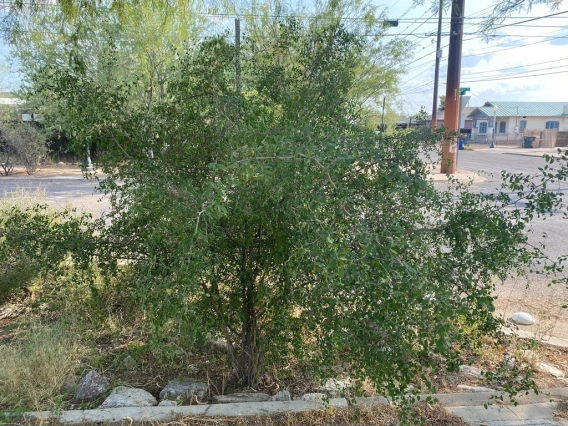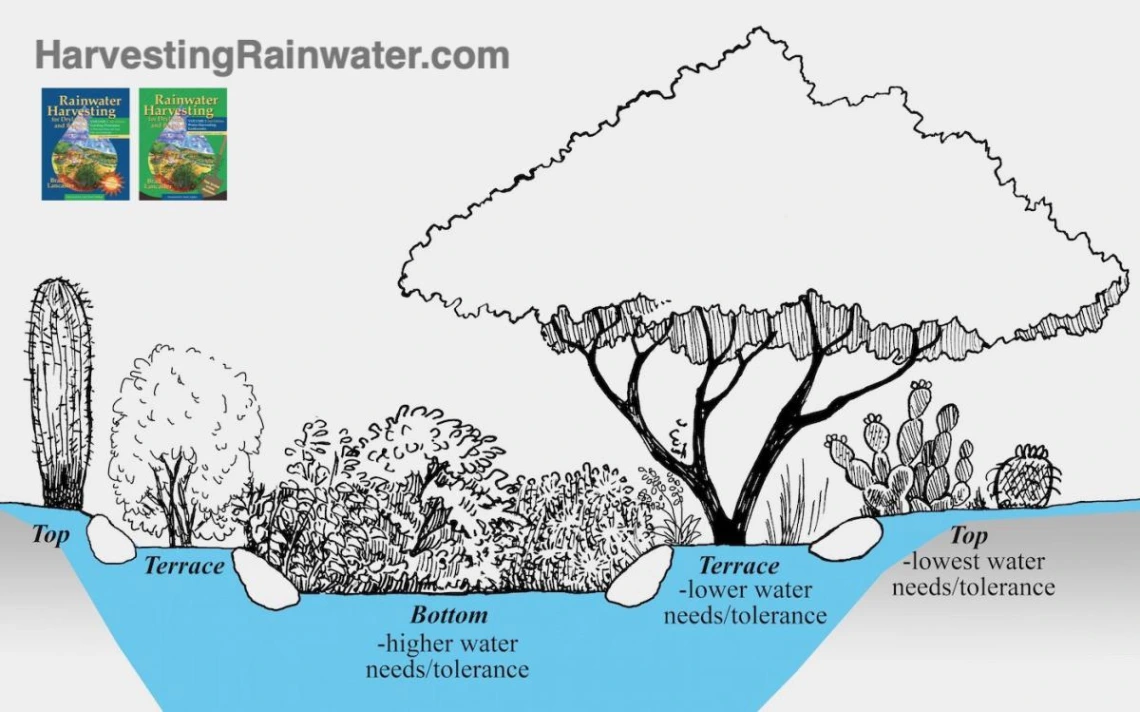

Common Names:
- English: Desert Hackberry
- Spanish: Garambullo
- O'odham: Kuwavul
Family: Cannabaceae
Botanical Name: Celtis pallida | Synonym: Celtis ehrenbergiana
Rain Garden Zone: C. pallida thrives in the terrace rain garden zone; however, it may also grow well in the top rain garden zone. The terrace zone is typically atop a terrace or on the bank of a basin or swale. These sites have more shallow, less-frequent, and more temporary pooling than in bottom zone. The top zone, is the area beside, but not in the basin where plant root crowns stay dry, but where roots can access water harvested below in the basin. This location is the driest and warmest of the three zones.

Reproduced with permission from "Rainwater Harvesting for Drylands and Beyond" by Brad Lancaster, HarvestingRainwater.com
Flowering Season: July - August (wet summer)
Harvest Season: September - November
Harvest Techniques: Ripe berries can be picked from bushes, making sure to leave enough for the wildlife that feed on the berries. Take care not to damage the stems.
Planting Season: Monsoon
Landscape Cultivation: Fresh seeds may be planted directly without scarification. Non-fresh seeds can be soaked in citric acid for 24 hours before planting.
Characteristics: C. pallida is a semi-deciduous shrub capable of reaching heights between 1 and 6 meters. The branches are dense with paired, straight spines with thorns at the tips of the branches. The flowers are a greenish-yellow and grow at the leaf base. The fruit is a yellow or orange berry enclosing a single seed. Desert hackberry can generally be found along washes or on rocky slopes.
Ecological Benefits: Desert Hackberry fruit provides food for mammals and birds, and the flowers attract bees, butterflies, and other pollinators. Desert Hackberry and Canyon Hackberry alike provide shelter for birds and small mammals, who support plant health by fertilizing the soil beneath the tree's canopy. American Snout Butterflies lay their eggs on Desert Hackberry plants. Organic matter is also added to the surrounding earth around the hackberry as this species is deciduous and drops its leaves during periods of cold or drought.
Practical Uses:
- Food - Desert hackberry is a source of niacin, magnesium, calcium, protein, and phosphorus. Hackberries have a sweet, melon-like flavor and are best eaten fresh or frozen for later use. These berries can be cooked into jams and sauces, canned, or baked into deserts.
- Domestic Animals - The desert hackberry shrub is an excellent source of feed for chickens and cattle to graze on. Additionally, honey bees are attracted to the plant’s nectar, pollinate them, and make honey.
References:
- Desert Harvesters. (2018). Eat mesquite and more: a cookbook for Sonoran desert foods and living. Tucson, AZ. RainSource Press.
- Hodgson, W. C. (2001). Food plants of the Sonoran desert. Tucson, AZ. University of Arizona Press.
- Lancaster, B. (2019) Rainwater harvesting for drylands and beyond, 3rd edition. Tucson, AZ. RainSource Press.
- Little, E. L. (1980). The Audubon Society field guide to North American trees, western region. Alfred A. Knopf.
- Rea, Amadeo M. (1997). At The Desert's Green Edge - An Ethnobotany of the Gila River Pima. Tucson, AZ. University of Arizona Press.
- https://www.wildflower.org/plants/result.php?id_plant=ceeh
- http://swbiodiversity.org/seinet/taxa/index.php?taxon=Celtis+ehrenbergia...
For more information on this plant, see the Campus Arboretum species description pages.
Go to the next tour stop: whitethorn acacia page or Return to the main Dunbar Spring tour page

